Small Woodland Sunflower, Small-headed Sunflower - Helianthus microcephalus
|
Helianthus microcephalus - Small Woodland Sunflower, Small-headed Sunflower. This is one of just a few Helianthus species which normally has fewer than 10 ray florets (petals.) Both the rays and disk are yellow. This plant is native to the eastern part of the United States, mostly south and central. The stem is smooth, sometimes glaucous, and the opposing lanceolate leaves are quite rough on the upper surface.
Found in:
AL, AR, CT, FL, GA, IL, IN, KY, LA, MD, MI, MN, MO, MS, NC, NJ, OH, PA, SC, TN, VA, WV
Leave comments on Helianthus microcephalus at this link. | 
Distribution of Helianthus microcephalus in the United States and Canada:

Blue=Native; Grey=Introduced
Map from USDA Plants Database:
USDA, NRCS. 2017. The PLANTS Database (http://plants.usda.gov, 08 May 2025). National Plant Data Team, Greensboro, NC 27401-4901 USA.
Search Our Database: Enter any portion of the Scientific, Common Name, or both.
Do a general Google search of the entire site:
#ad
 Follow USWildflowers on Twitter
#ad
| | Site: Walker County, GA Date: 2009-November-25 | Photographer: Gerald C. Williamson
Nikon D60
1/60f/8 IS200
Tamron SP 90MM f/2.8 AF Macro
90mm (135 equiv) | | The Small-headed Sunflower normally has 5 to 8 slightly ribbed yellow ray florets surrounding a yellow central disk. Small bees are included in their pollinators. | | 
| | Site: Monteagle Mountain, Grundy County, TN Date: 2011-September-17 | Photographer: Gerald C Williamson
Nikon D7000 | | Helianthus microcephalus may have several blossoms in the inflorescence. | | Click on the photo for a larger image
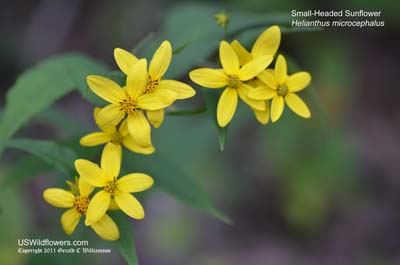
| | Site: Walker County, Ga Date: 2009-November-25 | Photographer: Gerald C Williamson
Nikon D60
1/60f/8 ISO200
Tamron SP 90MM f/2.8 AF Macro
90mm (135 equiv) | | This side view of the small-headed sunflower blossom shows recurved, slightly hairy involucres bracts and the pubescent upper part of the peduncle. | | Click on the photo for a larger image
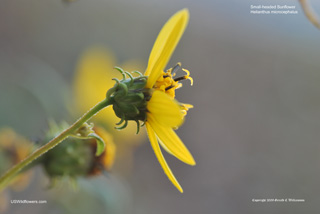
| | Site: Walker County, Ga Date: 2009-November-25 | Photographer: Gerald C Williamson
Nikon D60
1/60f/8 ISO200
Tamron SP 90MM f/2.8 AF Macro
90mm (135 equiv) | | Helianthus microcephalus is smooth-stemmed (except in the inflorescence) with opposite lanceolate leaves. The single inflorescence on this specimen terminates a single stem with several flowers, but may have multiple flower stems arising from leaf axils in the upper half of the plant, each terminating in a multi-flowered inflorescence. | | Click on the photo for a larger image
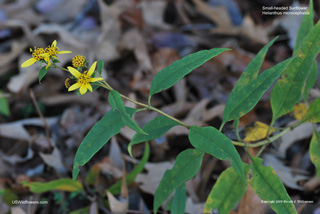
| | Site: Walker County, Ga Date: 2009-November-25 | Photographer: Gerald C Williamson
Nikon D60
1/60f/8 ISO200
Tamron SP 90MM f/2.8 AF Macro
90mm (135 equiv) | | This quote from Jack B. Carman in his excellent book Wildflowers of Tennessee describes the leaves nicely: "The leaves, from 3 to 6 in. long and .8 to 2 in. wide, are mostly scabrous above, resin-dotted, entire or toothed, lanceolate to lance-ovate, abruptly narrowed to about a 1 in. petiole." In this specimen, the you can see sparse, minute teeth and some of the resin dots on the center-veined leaf. | | Click on the photo for a larger image
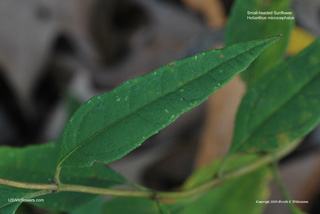
| | Site: Walker County, Ga Date: 2009-November-25 | Photographer: Gerald C Williamson
Nikon D60
1/40f/11 ISO200
Tamron SP 90MM f/2.8 AF Macro
90mm (135 equiv) | | Helianthus microcephalus normally has several blossoms in each inflorescence. Since each plant may contain multiple flower clusters, the many flowers can become a fall cornucopia of food for the bird population. | | Click on the photo for a larger image
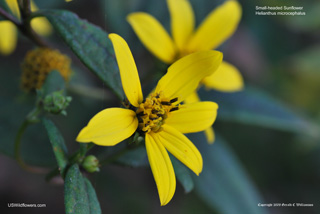
| | Site: Blue Hole Area, Pigeon Mountain, Walker County, GA Date: 2012-September-16 | Photographer: Gerald C Williamson
Nikon D7000 | | Spider on Helianthus microcephalus blossom. | | Click on the photo for a larger image
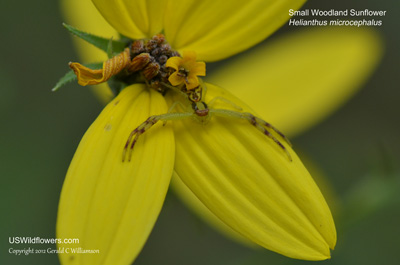
|
References used for identification and information:
|
|
| |
| #ad
|
|









